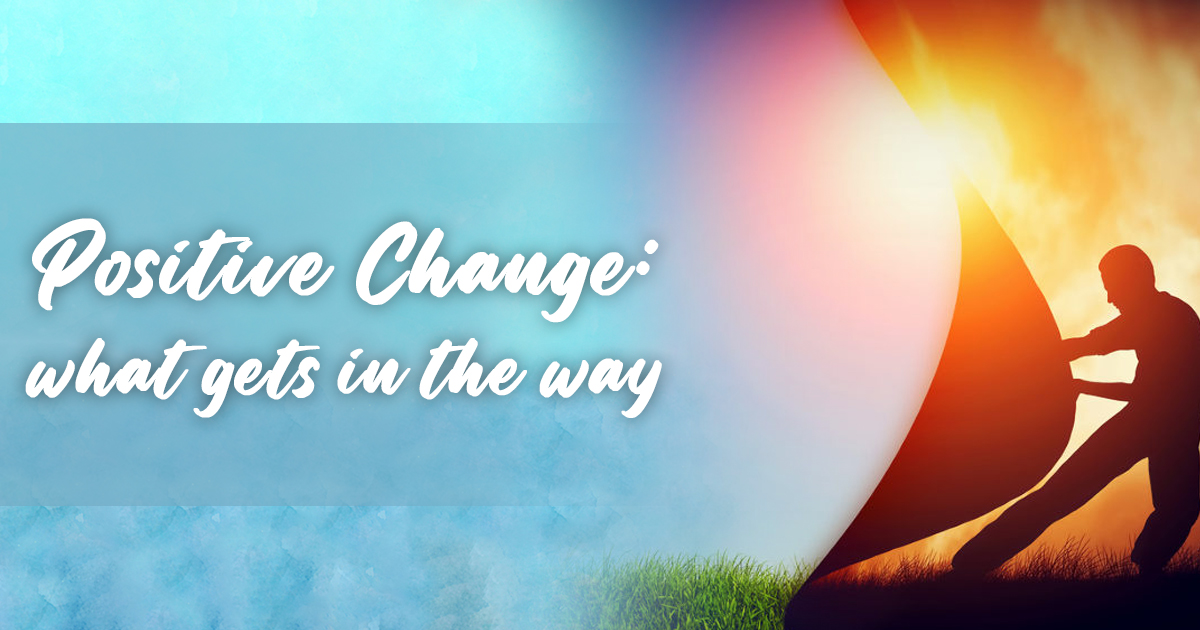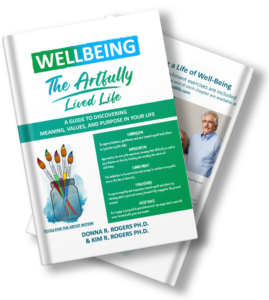What gets in the way of Positive Change?
Many of the articles and blogs I have read addressing well-being seem to contain lists of possible changes to our thinking and behavior that will make us happier and increase our well-being. They typically list 5-10 behaviors that lower stress (or rather the negative effects of stress) and increase our sense of well-being. These concepts, ways of thinking and behaviors, some of which you will find in my blogs as well, are often of great value. They may in fact seem like something you would like to try. But alas, after a few days they fade away and are replaced by the next set of good ideas that you come across. So, the question becomes – what gets in the way of the positive changes that we want to work toward in our everyday lives?
When we contemplate change, this laundry list of things that we should do may begin to feel overwhelming like our list of New year’s resolutions. They typically become replaced by what we have always done in a month or two. A recent study has shown that the success rate for changing multiple behavior habits at the same time was very low as compared to focusing on a single behavior. You are likely to be more successful by choosing one positive change and turning it into a habit before moving on to another. Prioritize – pick a new way of thinking and resulting behavior that is meaningful to you (a change that you can actually make progress with). Next, consider what roadblocks might get in the way of the positive change you want to make. Here are a few things to consider. Remember that some of them may be more relevant to your circumstance so be aware of and focus on those.
Roadblocks That May Get in Your Way:
Negative Influences and Environments: Try to be aware of and possibly remove or limit time spent with people and media that promote negative thinking as well as unhealthy habits and attitudes. These influences can be subtle and pervasive.
Fear and Doubt: Fear of failure or uncertainty can hold you back from making positive changes, leading to a sense of stagnation. Remember that everyone not only experiences failure but at times may experience a fear of failure that may paralyze their ability to move forward positive change. The important thing is to acknowledge your fear and act anyway. If you can redefine failure as a necessary step in your progress, it does not need to keep you from doing what is most important in your life.
Lack of Accountability: Consider sharing your goals, progress and set-backs with your support network or perhaps an accountability partner. Without this support, you may find yourself becoming overwhelmed, and your motivation fading.
Unrealistic Expectations and Perfectionism: Setting unrealistic goals or expecting immediate results can lead to frustration and discouragement. You are not likely to accomplish your intended change on the first attempt. Positive change is a journey not an event.
Lack of Resources and Skills: It is critical to access resources, skills, and knowledge concerning the particular change that you are making. A bullet statement on a list will not likely be sufficient to understand how the concept or behavior that you wish to adopt will work for you in your life.
Internalized Negative Beliefs and Self-Doubt: Negative self-talk, self-doubt, and internalized negative beliefs can hold you back from making positive changes. Overcoming these negative beliefs about yourself and the world will require awareness, self-reflection and reframing. Reframing the situation involves looking for opportunity instead of focusing on a limitation or failure. Internalized negative beliefs about yourself are often difficult to recognize. If you believe this is holding you back, you may consider seeking professional help.
Just like the list of positive characteristics that you want to make, these possible roadblocks do not need to be an overwhelming laundry list of things that you need to address at once. Choose one or two that are most relevant to you and work on those. Just remain aware of the others if they start to slow you down.
Stages of Change:
Once you have selected the specific change that you want to make, the next step might be to decide your level of commitment. The transtheoretical model (TTM) has been demonstrated in clinical settings to provide a basic understanding for changing behavior. Although it has been typically applied to changing behaviors such as smoking, alcohol abuse, addiction, and weight control, it may also be useful in better understanding positive life changes. The 5 stages for change include Precontemplation, Contemplation, Preparation, Action, and Maintenance.
Since you are visiting this website and are reading this blog you are likely beyond Precontemplation which had been defined as those who are unmotivated and see no need to find a solution to a problem because they usually do not believe that one exists.
In the Contemplation stage, individuals show awareness and acknowledgment of the need for a positive change and have serious consideration to change. However, the person is uncertain whether this change is worth the effort or that they can make this change.
If you have moved past the contemplation stage and into the continuum of the Preparation stage, you have made a commitment to your positive change. You may have decided that the pros of changing behavior outweigh the cons and have started to gather information from various sources, self-help books, articles, etc. You may have even developed a plan of action. Gathering information and developing skills is a vital step in preparation.
During the action stage, change happens. You will likely gain confidence as you believe you have the willpower to continue the journey of change. In this stage it is particularly helpful to rely on your support network or accountability partner.
Continuing your new behavior is the focus of the Maintenance stage. As you continue your new behavior or way of thinking, it will become a new habit.
At times, you may have thoughts of returning to old habits. This often happens when challenges or setbacks happen in other areas of your life such as illness, job loss, relationship problems, etc. However, remember that you can resist the temptation to return to old unhealthy habits and remain on track if you remain aware of the positive strides you have already made.
Once you have experienced adopting one positive change in your life, your next choice is likely to be easier. There are several reasons for this. Research has suggested that positive practices toward self and others such as kindness, empathy and compassion are linked. In addition, when practiced together gratitude and forgiveness have been shown to cultivate a sense of acceptance and compassion. The constellation of practices and behaviors that increase well-being and life satisfaction are linked together in many ways.
In conclusion, start small with one or two positive changes among the 5 or 10 concepts and behaviors proposed to increase your happiness and well-being. Determine your level of commitment to positive change. Then identify and work with whatever may be getting in your way. Assess your environment, acknowledge your underlying fears or reservations and act anyway, connect with your support network, set realistic expectations, look for information you need, and ask those who know you best to help you identify your negative beliefs. Finally, as Dr. Seuss would say, “You have brains in your head and you have feet in your shoes, you can steer yourself any direction you choose. You’re on your own and you know what you know, and you are the one who’ll decide where to go”.
Where can I find additional information?
“WellBeing: The Artfully Lived Life,” is a complete guide to psychological well-being; a holistic concept, encompassing all aspects of our lives. This book offers a wealth of insights and practical advice for practicing mindfulness, fostering meaningful relationships and engaging in thinking and behavior that brings joy and fulfilment in your life. Taking small steps each day can lead to transformative changes in your well-being, ultimately leading to a more balanced and artful existence.


